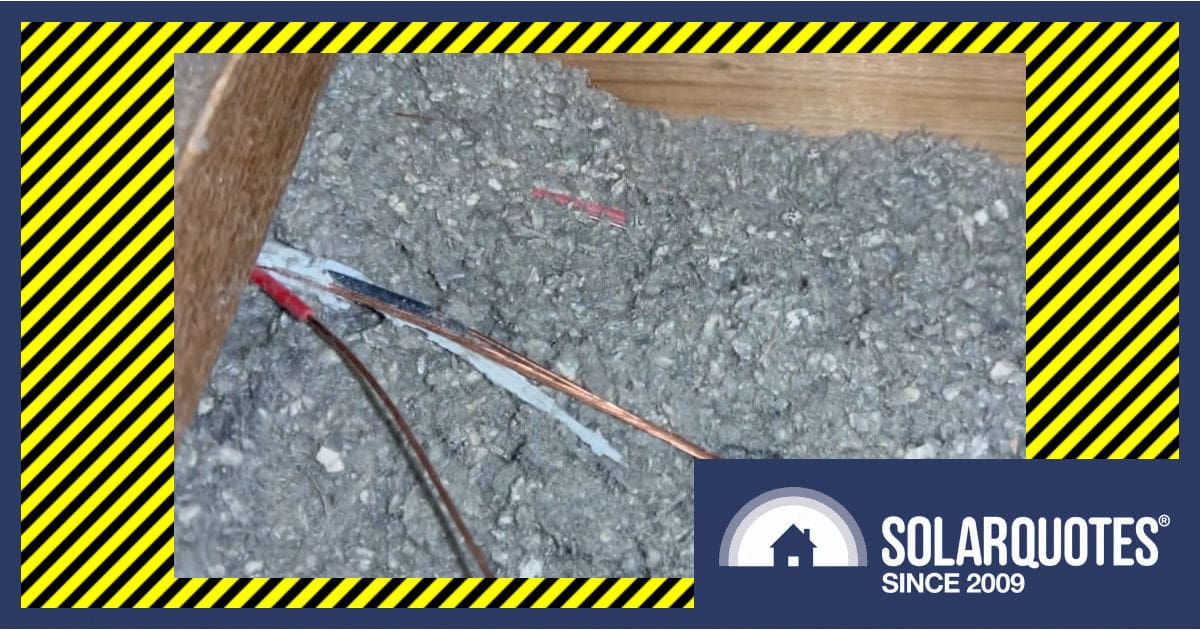
Hard to believe, but this shiny, stripped copper cable inside a house roof is the handiwork of birds!
Electricity is crucial in modern society, powering almost everything we use daily. In Australia, working with anything over 50 volts AC or 120 volts DC (ripple-free) requires a licensed electrician.
Sure, some folks see that as government overreach and featherbedding by the sparkies’ union. But there’s a good reason you don’t want your unlicensed cousin working on the high-voltage stuff at your home or office. Electricity can easily kill if mishandled.
This post hopes to highlight just how dangerous working on Australian homes can be.
There Are Exceptions
Electricians aren’t infallible. I recall an incident where an unidentified electrician accidentally cut off power to a construction site, leading to a chaotic situation where everyone suddenly had to walk buckets of concrete up the stairs . Without electricity, the materials lift was now out of action, and no electrician wants to bear the wrath of an angry concreter or have to buy them cartons of beer in compensation.
Don’t Begrudge Electrical Safety
When an electrician, or anyone else, turns up to work on your house, the last thing you want them to do is turn the power off. It’s terribly inconvenient, after all. The thing is that in many cases, it’s illegal for a worker to enter a confined space like your ceiling cavity, without first isolating the supply.
What’s more inconvenient than turning the telly and the lights off? Having the police, ambulance, fire service and SES turn up to tear your roof off, and extract a lifeless body.
That might sound like hyperbole, too, but it happens more often than many people would be comfortable knowing. In fact, 4% of work-related deaths are caused by contact with electricity, seven electrical workers don’t go home each year, and the nature of the work and demographics means they’re often young blokes with families.
This is also why – tempting as it may be – throwing an extension cord over the fence to solar power your neighbour’s garden shed is highly illegal. You can’t have more than one supply to a premises.
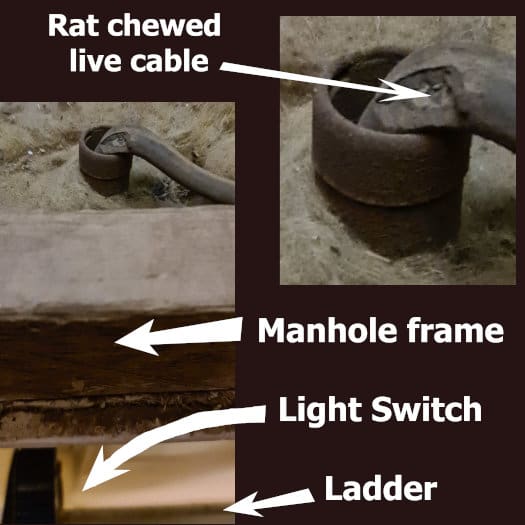
Right where you crawl through the manhole is a dumb place to put this metal conduit, but the rat-chewed insulation takes the cake.
New Houses Aren’t Immune
Residual current devices (RCDs) have been compulsory for years now, so modern houses are inherently safer due to “safety switches” being the default. Yet, this doesn’t rule out the risk of pests gnawing on your wiring, exposing live parts with a dangerous bite. The electrician who found the fault pictured below thought the damage was due to rats, but actually, it was birds that chewed this wiring clean. Thankfully, this house wasn’t burnt down in the process.
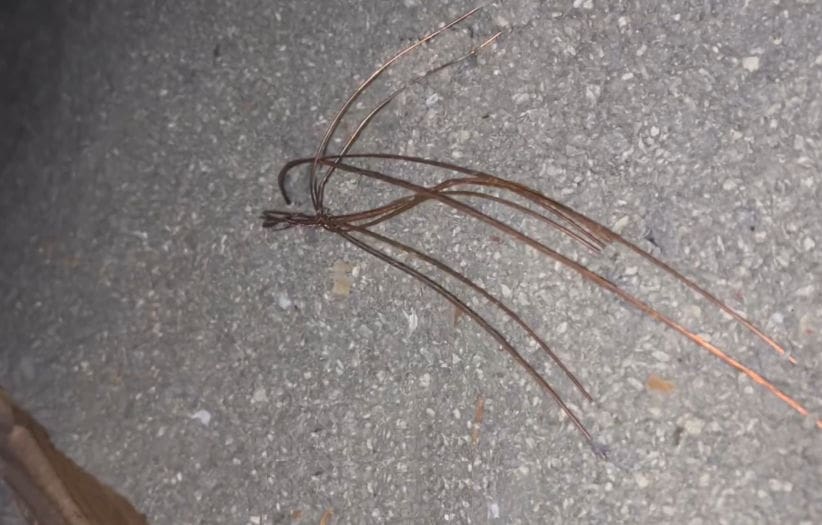
Loose fill blow-in insulation, yes; electrical insulation, NO! These lighting cables are totally bare.
I’ve gathered some images recently from a few electricians’ forums as well as a selection of connections that have tried to kill me personally in the last few years, but read on for some prime examples of why you should always check carefully when working around the house and bear in mind that not everyone follows the rules.
Old Houses Can Hide Great Dangers
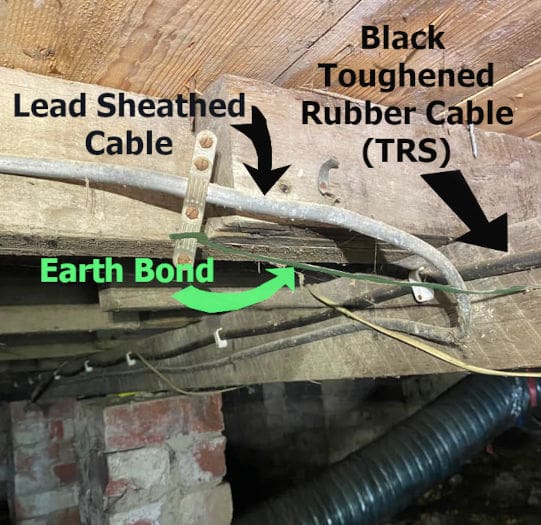
Lead sheath is very unusual to find but equally dangerous because nobody realises electrical cables ever came in flexible metal format.
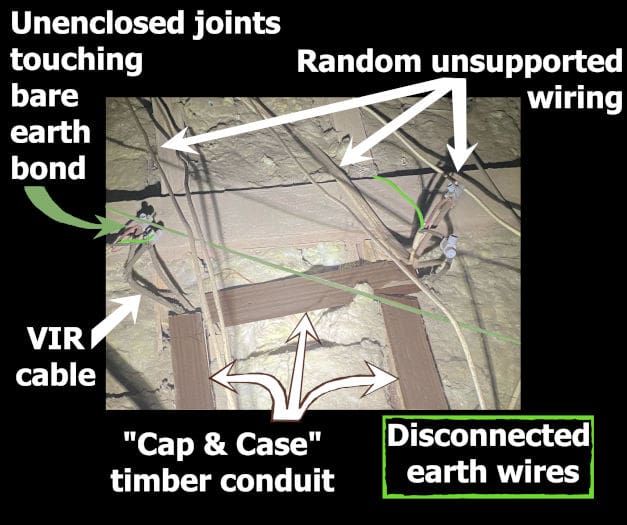
Yes, wood can be used as a conduit, too. Arguably not as dangerous as a metal conduit, I’ve seen this type of wiring still in service at what could be 100 years old.
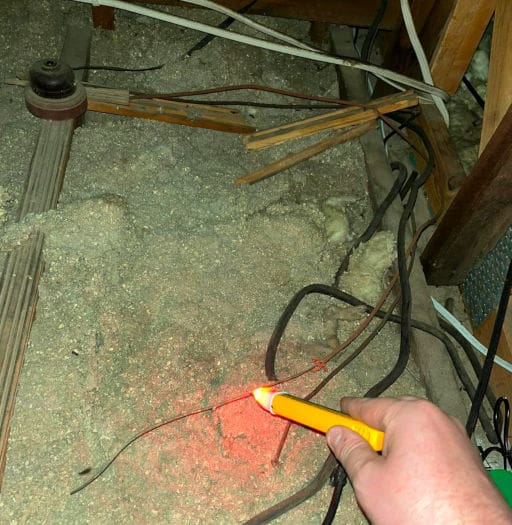
Never mind the new cables added over a broken wooden conduit(!) That red glow is a “volt stick”, which indicates that stripped bare VIR cable is laying there casually, exposed, open and LIVE.
Toughened Rubber Sheath (TRS)
TRS was common after WW2, and in many cases, it’s fine until it’s disturbed. However, because it becomes incredibly brittle, you don’t need much force to make it crumble and fall away like sugar from the side of your cocktail glass. The bare wires can give you a much worse headache though.
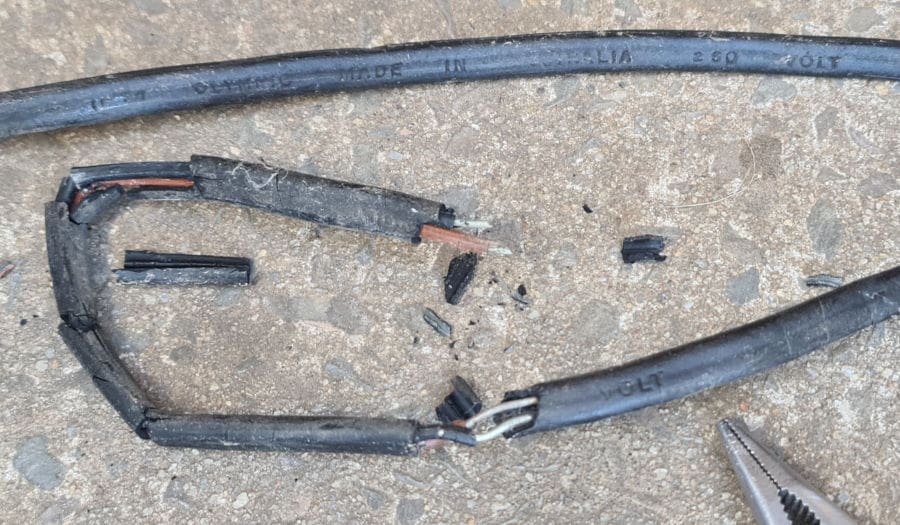
Olympic – Made In Australia – 250 Volt. This toughened rubber sheath cable was found in a house that had been “totally rewired” but the dodgey prick involved didn’t change all the wiring. It was my house and rest assured the bloke doesn’t work for me anymore.
Vulcanised Indian Rubber
What is arguably more dangerous is Vulcanised Indian Rubber cable, which looks like a shoelace. It has a woven cotton sheath, often protected inside a black-painted steel conduit. Once again, the rubber insulation becomes brittle and crumbly because it’s much the same as TRS, rubber insulation that was once soft, but VIR doesn’t have the smooth black sheath.
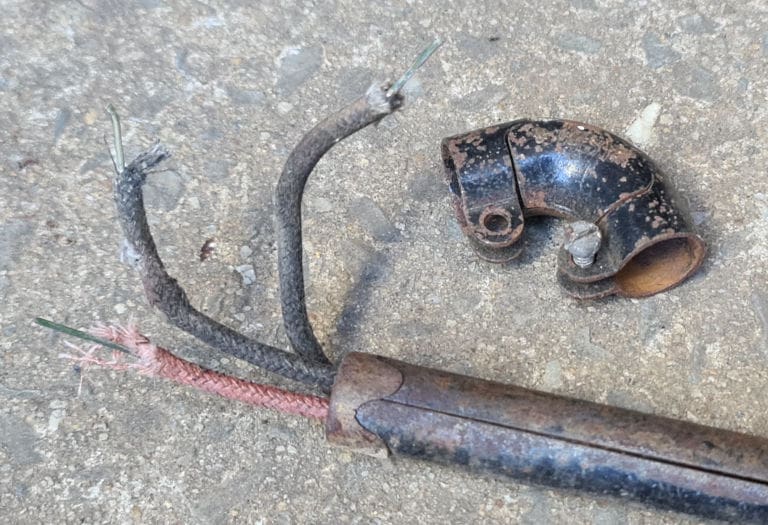
Fun Fact. The brand name “Clipsal” was derived from fittings like this elbow that would work with many different brands & sizes of pre-standard conduit. It was a range that “clips all’ types of conduit together.
What VIR does have is a death trap.
Wiring systems in old houses rely on the split seam steel conduit to form the protective earth bond, only for socket outlets in wet areas like laundries and kitchens. Light fittings, the mantel radio and your bedroom, didn’t have an earth at all. (Did the bedroom even have a PowerPoint?)
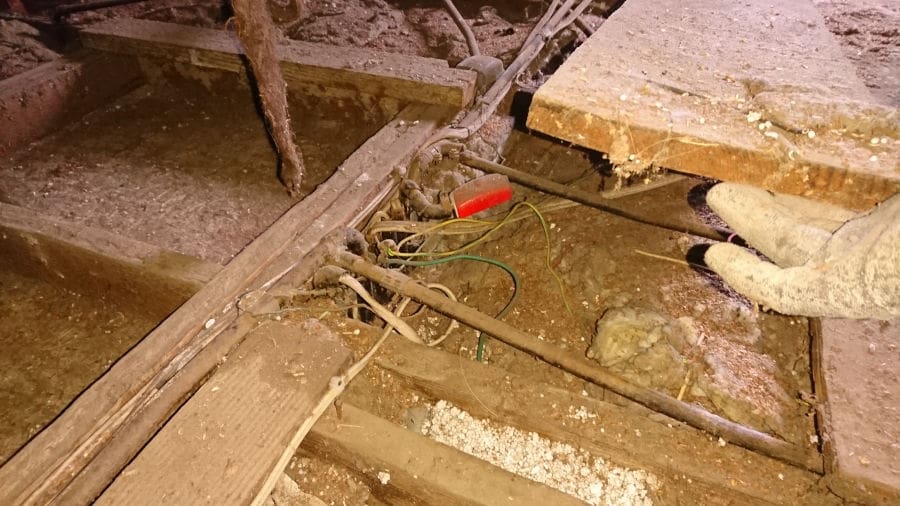
Crawl board I had just lifted off reveals the mess of wiring right near the manhole
The problem with split steel conduit is that if someone steps on it and separates the parts, the earth path is broken. Worse still, it’s not very strong. The act of stepping on the conduit can easily cause it to cut the old brittle cables inside like a scissor, leaving a live steel pipe in the roof for you to place your hand on, or a live metal appliance in the room that is fed by this now compromised circuit.
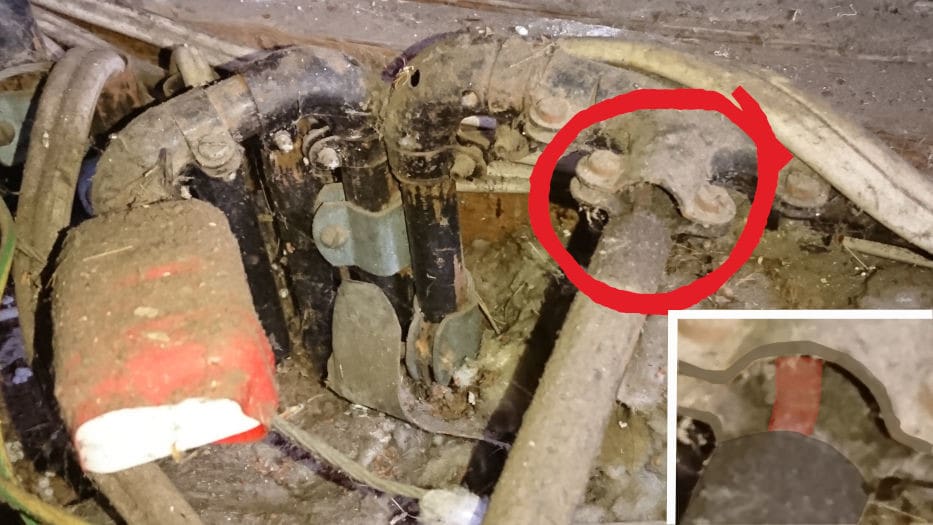
Live cable with a steel conduit resting on it. This is death on a stick I managed to avoid.
This particular job was a pretty complex solar layout, so there were four separate arrays to run HD solar conduit and wiring through the roof. We managed not to damage anything, but the owner was disappointed that her nephew, a supposed electrician, hadn’t rewired the place like he said he had.
I was disappointed that this all has to be replaced. The original installation was obviously well done by someone who cared about their work, but 70-odd years have taken its toll.
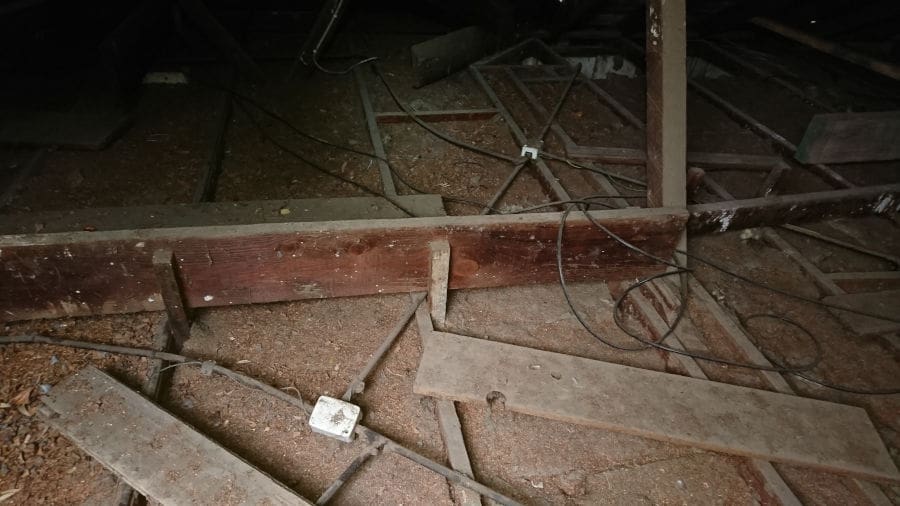
Plastic junction boxes on steel conduit means someone has been fiddling. Nothing good is going to come out of this.
In Western Australia there are laws meaning that if an electrician finds these rubber insulated cables in your house, they’re obliged to report them or replace them.
Be Careful Out There
Many people think it can’t happen to them, and they take some risks that aren’t necessary. I know because I was one of those who would tell the customers we’ll only have the power off for a few minutes. I urge people to recognize their own power in ensuring safety, by taking a proactive approach. Tell your electrician you don’t want them in the roof when the power is on, and take an interest in seeing they show you how to turn it off yourself.
One of the best work health and safety experiences I ever had was a high-rise building manager. Knowing the weather would be diabolically hot, he sought out and printed off our solar company WHS policy and stuck it on the roof access door. Then he watched as the temperature rose 10 degrees in an hour and hounded us off his roof once it hit 38°C.
In another post, I’ll look at yet more dodgy wiring and explain how some people get away with being unlicensed electricians.

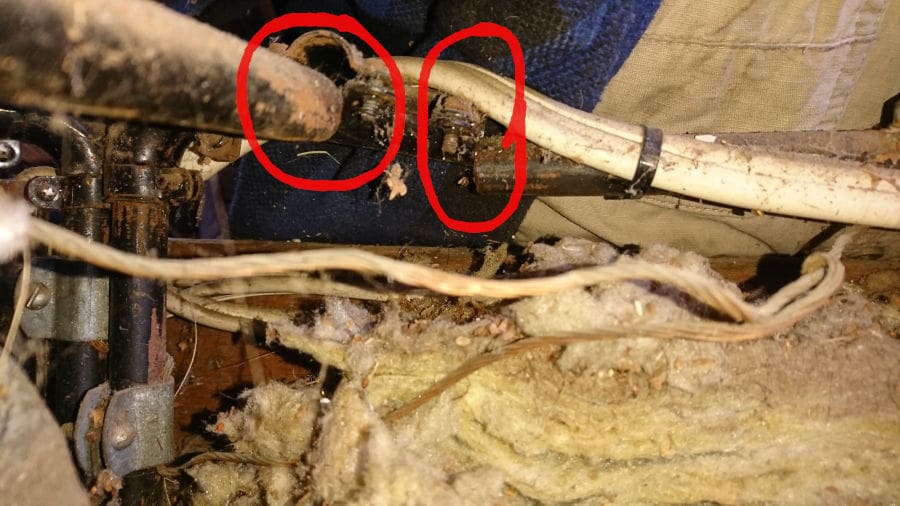
 RSS - Posts
RSS - Posts



Another comment from a member of the electrician unions that claims to be an expert, but doesn’t even know that domestic houses use low voltage, not “high-voltage stuff”. 230V is not 1000V+.
Then he give you the Fear of God as he shows countless examples of obsolete failing electrical wire or inproper electrical installations.
Then he goes on to tell you not to trust your electrician. He gives you plenty of examples where they didn’t do a job as expected and owners expresses dissapointment. Including the author. He then proceeds to tell you “the public” to know better than the “expert” electrician and force him to switch off the power.
This is a classic example of why I have reduced trust in certifications and qualifications within Australia. Obviously we don’t trust the qualification, as owners we are expected to control a qualified expert electrician. If we had some knowledge on home electrical wiring like in New Zealand, that uses the same electrical AS/NZS 3000 standards, maybe we might have some understanding and authority to challenge poor work practicies. But of course the electrians union in Australia won’t let that happen, because that would reduce thier monopoly.
Hi George,
I’ve seen first hand the customer who will browbeat an electrician into dangerous work practices. I have been that worker who has to balance customer expectations, realistic or otherwise, and I have been very pleased to find a customer who’s prepared themselves with a good book and a thermos of tea because they fully expect you to turn the power off.
I’ve also known an electrician to be killed by a faulty light fitting, because the real estate agent didn’t want to turn their computer off. The silly bastard didn’t walk away at that point and despite his expertise and his license, the misjudgement killed him. The customer has to live with the consequence of their expectations.
Professional electricians do argue that the image showing the volt stick could not be taken if you followed the law in Western Australia. Entering the roof space with the power turned off would mean this fault might not be found.
The article is about setting expectations. Customers should realise that employing someone to run new circuits in a “best price wins” situation means that existing faults will be overlooked, corners will be cut, broken wooden conduits will be ignored and so on.
If you reckon it’s easy then I suggest you sign up for an apprenticeship, it’s only 4 years.
It is never customer’s fault that licensed electrician has died. It only proves whoever granted him license was wrong.
To be fair while supply and load wiring is officially low voltage LV, it’s an industry term. The target audience for the blog isnt tradie electricians or electrical engineers its homeowners. So describing Home wiring as high voltage stuff is relevant to the audience.
100% agree!
Same electrical code in New Zealand as Australia, yet, home owners can DIY there and work safe even puts together a how to guide.
https://www.worksafe.govt.nz/dmsdocument/1580-new-zealand-electrical-code-of-practice-for-homeowneroccupiers-electrical-wiring-work-in-domestic-installations-nzecp-51-2004
This culture of trying to hide how to do things properly to protect a trade is unsafe. There should be more of an effort to educate the public on how to do it safely and let people decide themselves if they have the skills / knowledge to do it themselves or if they should call in a professional. Which is why I really enjoy reading this blog.
I think most people know that some home owners will attempt to do their own electrical at some point in time (even though there are numerous signs saying it’s illegal). This is evidenced in all the “dodgy” electrical wiring posts that people have come across. I would argue that it’s silly we don’t provide the tools / information necessary for them to do MINOR modifications safely (for themselves and others). It’s one thing for a homeowner to work on an outlet / lighting socket downstream of an RFCI protected to 30mA (trip in less than 300ms which is designed to be in the safety zone where ventricular fibrillation would not be expected to occur) and another thing for a homeowner to be working behind their main circuit breaker trying to run a new circuit.
As indicated above, Australia and New Zealand have the exact same electrical code AS/NZS 3000, however, as a homeowner in New Zealand, you can do MINOR modifications. It’s your house, you live in it, it’s in your own best interest to ensure whatever you do that it’s within your capability and competence. This practice is typical around the world as well, probably because it’s too difficult to regulate. In the interest of public safety, it’s better to educate and let people make their own decisions.
The average muggins can probably manage some water plumbing, ‘cos leaks are fairly obvious, but gas plumbing can be lethal. Energetic electrons are even less forgiving than gas. (Don’t ask me how I know that 385 Vac can throw you across the room, even if both nearly-completely-insulated wires only brush a finger. It could have been death by broken neck, as I hit the far wall. Try it up a ladder, perhaps?)
My diploma of electrical engineering doesn’t entitle me to take a screwdriver to fixed wiring above ELV. At age 70, I’m willing to admit that the hands-on experience of a younger electrician, with a newer copy of AS3000 than mine from last century, is well worth paying for. (Even the equal aged electrician mate I called in last month does a better and safer job than I could guarantee I’d always do, nowadays.)
To the cowboys I’d just say it probably isn’t worth the risk of the house burning down, and your widow not being able to claim on insurance, due to your fatal error.
Even on the 48 Vdc side of my solar installation, I’ll let the sparky crimp the lugs on the 35 sq mm cables, not just because I don’t have a hydraulic crimper, but at those currents, a gas-tight connection is vital. (But I am building the battery bank, as all that BMS & balancer stuff is quite interesting.)
Good ‘on Yer maaate.
Welcome to the world of different realities where even the best intentioned outlooks are subject to the rantings of a FOOL (you) !!!
Never trust “green steam” unless you have personally inspected the shutoff event and verified the non presence of it at logical positions around the structure.
In you Article intro, where you state the figures for AC and DC where if you go above its no longer considered ELV and is regulated LV . I think you have them around the wrong way.
Cheers Lyle,
I’m glad someone is paying attention; because it’s all too easy to make mistakes with electricity.
guys,
I’m with Anthony on this one. Back in the old days when I used to work for the then Electricity Trust of South Australia ,the variety of new and unique ways for people to electrocute themselves never cease to amaze me. And just about every one of them was avoidable.
I’ve yet to meet anyone – general population or trade qualified sparky – that claims they have learnt everything there is to know about electrical safety.
So when someone goes to the trouble of Illustrating the kind of problems he has run into over the years, focus on the lessons learnt. It just may save someone’s life.
Keep up the good work Anthony.
Cheers,
Allan Hunter
I guess my problem with electricians is when I ask them to do a job, I specifically lay out what needs to be done and they do something else because the job hasn’t been properly communicated by the person running the company.
It resulted in extra equipment having to be bought at the electrician’s expense and reduced flexibility in the system for me, the customer. Because the labour involved to run the extra cable they “thought they didn’t need” was more expensive than buying a bit of kit.
So unless I sit there and watch them do the whole job (which kind of defeats the purpose of hiring someone) you don’t necessarily get a great job.
I know I could have done this job better myself but of course I wouldn’t want to break the law…
If we still had Installation inspectors instead of self inspections we would ALL be better off. As an electrical contractor for quite a few years I always looked upon inspection as extra insurance.
I appreciate the broad thrust of this article. I will note that in many places outside Australia, minor electrical works are permitted by non-licenced people (the specifics vary). This includes NZ which operates to the same standards we do.
Do I think DIYers should wiring a house? No. Should I be allowed to change a light fitting or power point? I think so.
The thing, when everything is prohibited people are just going to do it anyway.
Good thing we have RCD’s on most circuits, which has made accidentally contacting the live cable much more forgiving. New rules stipulate RCD’s on hard-wired appliances. We just don’t have the same level of risk with newer construction like we did in the old days.
https://www.commerce.wa.gov.au/building-and-energy/rcd-requirements-sale-rent-and-hire-properties
People keep throwing statements around like your house is going to burn down from inadequate wiring done by an unlicensed home owner, yet, that’s not the case for other states around the world. Yes – there will some incompetent individuals that create safety hazards, but give people the tools / education and I would argue that they would do a better job than most tradies as they would take their time and not try to smash out jobs in as short of time as possible.
It’s shocking that arc fault detection devices (AFCI) aren’t common yet over in Australia to detect and protect against hot joints (probably the more common cause of house’s burning down).
Mitch, I agree with your second paragraph
The RCDs do not guarantee you protection! At work, we worked on buses and one of the guys was loosening the wheel nuts with a long bar. One was very tight, so he jumped on the bar, and it came down, cutting an extension cord on the ground. The workshop lights flickered, and then I realised, the entire bus was live! I screamed for everyone to stay still and not touch anything. I called one of the other workers to go and hit the main switch.
I still can not determine what happened, but the bus was live and needed more work. Don’t take RCDs for granted. I have my power pen handy.
Well, RCD is good but also causes disruptions for no good reason. TN-C was problematic but since TN-S or TN-C-S replaced it making RCD possible, in fact it might be good even without RCD. I also remember use of separating transformers for outdoor devices (and all prone to touch as well) to emulate small IT circuit. Used it sometimes when I did it for living, it is even better than RCD.
Yeah, so if it isn’t trade union making job expensive, why one can’t just pass a test to get a licence? Why electrician charges a lot more not only compared to GP but also a surgeon? Do they spend 20 years on education prior to taking on a job?
Why everyone who wants to be licensed for this field has to work for peanuts to get one?
My background is electronics and I also held low voltage licence in Europe (which is below 1kV). I did various things related to hands-on electronics and I remember – safe work with electricity connected is possible there and was part of my training at some point. Why? Well, you can’t fix electronic device whilst is offline as diagnostic can’t be conducted. It must be turned on and kept that way until cause of fault is known.
In a bit simplified version – to work safely with low voltage AC power, one need some ppe (say, a gumboots) and work with one hand only. The other hand has to be in a pocket to avoid tempting. Also not to lean on something.
In relation to the electrician who died fixing light point – well, in Europe I would do it as I said and I am sure I would be alive as I am now after working with live devices for years.
Not that I am saying do it at home, certainly don’t, but I am saying it is possible do work safely with live ac, cutting power isn’t the only measure. On top of that I would use live safety rules even when power is down, just in case it will return unexpectedly. There is also prevention measure by “grounding” offline live wire to work two hands, never saw electrician doing it here.
Hey, I’ve seen that vulcanised indian rubber! That was in our house. There was a metal conduit cutting the corner over our manhole in the ceiling, which I thought was particularly stupid. Asked an electrician I knew if he could move it…”NO! If I touch that, I’ll have to rewire the entire house!”
The fabric was crumbling off the lighting wires, I unscrewed the bakelite cover over the switch in my son’s room, and then screwed it straight back on again–“Nope! Not messing about with that accident-waiting-to-happen!” The actual light socket dangled on a pair of twisted wires from the ceiling light fitting, and eventually those twisted wires crumbled and shorted out. That was an easy fix. Switch off the light at the wall, pull the fuse from the meter, and tell the wife what I’m doing and that “No one is to touch those bloody fuses!”
Then just unscrew the old wires, replace with new, done is done. Just replacing like-for-like is really not difficult, and if you expect me, a pensioner, to call an electrician just to fix a dodgy light, it’s really not happening. Lack of attention could kill me? That’s true of anyone who goes on the road.
And if you’re wondering about that “Switch it off at the wall, and then ALSO pull the fuse.”, I used to work in a TAFE foundry. Occasionally I had to clean out the sand mill, an 8 foot drum thing with a spinning scythe that would throw around a ton of sand like a tossed salad. I would switch it off at the power box and tag it out. Then I would switch it off at the wall. Then I would unplug the thing. Then I would lock the door, with only me in the room. And then I would still feel nervous getting inside that thing.
Problem with the locked door is were you to suffer a life threatening medical event you may just die as a result as no-one would know or be able to easily access that location to supply useful help.
Would be good to know what approximate rewire costs are for a medium (3 bed single story) house are in the context of making an investment in rooftop solar.
Hi Morgan,
It’s a real length of string question but from what I’ve seen recently you’ll need to start with about $1200 – $1500 for a switchboard upgrade. If the switchboard has to be moved or there are faults like mixed neutrals that need troubleshooting, or if rewiring is actually a better/faster solution then that will all be additional cost. My uncle recently had a rewire and they ended up charging half the indicative quote but it took 5 days part time so having that flexibility helps a local contractor fill gaps. Best thing is to start with a plan and include hot water and EV charging.
https://support.solarquotes.com.au/hc/en-us/articles/6459857973775-Retrofit-consumption-monitoring-does-a-smart-meter-really-cost-750-
https://www.solarquotes.com.au/blog/ev-charging-industrial-socket/
https://www.solarquotes.com.au/blog/catch-solar-relay-review/
I installed a ceiling fan/light unit, I did it because I was confident that I could do the job easily. The ceiling light fitting gave me the first clue that it was not an easy job! What I saw was a shock and I took a photo and sent it to a sparky. They said that it was very common to just twist wires together and stuff them into very tight holes! All legal, but not very nice!
A small junction box would be nice.
It isn’t Sparky’s fault that our laws allow rubbish like this!
The ceiling fan units connectors were far too small to take the wiring.
I’m just wondering what a legit sparky would have done.
The other issue I had was the ensuite ceiling fan lights would play up from day one, that the house was built. In the end I got up to have a look and the live wire was pushed in between the plastic and the brass fitting, not the hole in the brass fitting! Which was tightened up!
Sorry, but if I do the job, I know that it’s right.
During my 50 years as a building contractor, I was completing a building estimate for some building work in the ceiling space of an old picture theatre, I grabbed hold of the wire, with both hands, which held up the sliding curtain mechanism, Someone previously in their wisdom had ‘installed’ a light and hung it across the wire. The light wire was wiring cable and over the years probably due to vibration and time, had worn the insulation through. I was thrown backwards holding the mechanism with both hands annd tearing the whole down, onto some deep ceiling joists knocking a large piece of my forehead off, while experiencing those 50 cycles a second and losing consciousness fast. Fortunately I had someone with me who twigged what was happening and his only recourse, because we were a long way from the switch, was to keep kicking one arm and I eventually was freed. I ended up with 3 large holes in one hand where the current had entered my body, a very bruised arm and a bloody forehead and fortunately my life.
Take that any way you like.Every day is a bonus.
Yeah, work with one hand only, I mentioned it somewhere above…. Unless you trust in what’s there.
Definitely agree with Australian electricity laws being too restrictive, coming from a country that allows reasonable DIY. I understand there are risks and shoddy workmanship which having a license doesn’t necessarily protect you from having a lazy corner cutter, but my biggest gripe is being quoted 300$+ to change a light switch especially considering i already bought the replacement. Unless I’m interrupting them with my call from some brain surgery they are currently in the middle of.